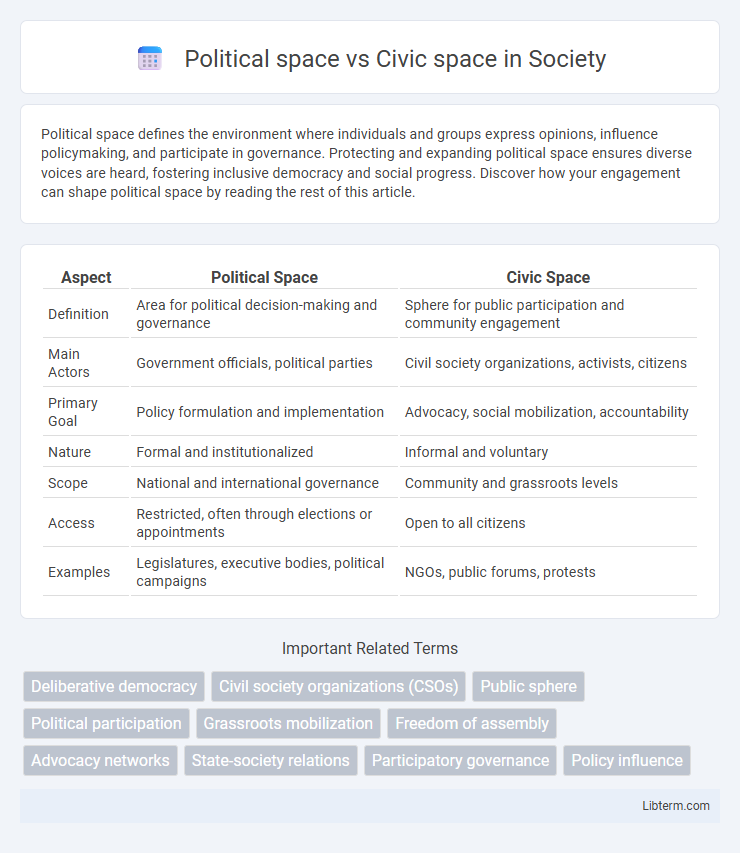Political space defines the environment where individuals and groups express opinions, influence policymaking, and participate in governance. Protecting and expanding political space ensures diverse voices are heard, fostering inclusive democracy and social progress. Discover how your engagement can shape political space by reading the rest of this article.
Table of Comparison
| Aspect | Political Space | Civic Space |
|---|---|---|
| Definition | Area for political decision-making and governance | Sphere for public participation and community engagement |
| Main Actors | Government officials, political parties | Civil society organizations, activists, citizens |
| Primary Goal | Policy formulation and implementation | Advocacy, social mobilization, accountability |
| Nature | Formal and institutionalized | Informal and voluntary |
| Scope | National and international governance | Community and grassroots levels |
| Access | Restricted, often through elections or appointments | Open to all citizens |
| Examples | Legislatures, executive bodies, political campaigns | NGOs, public forums, protests |
Defining Political Space and Civic Space
Political space refers to the arenas, institutions, and processes where power is exercised, policies are formulated, and political decisions are made, encompassing government bodies, political parties, and electoral systems. Civic space denotes the environments and opportunities that enable individuals and groups to organize, participate, and express their rights freely, including freedom of assembly, expression, and association. Defining political space involves identifying formal structures of authority and governance, while defining civic space centers on the capacity of society to engage in democratic dialogue and influence political and social change.
Historical Evolution of Political and Civic Spaces
Political space and civic space have evolved through distinct historical trajectories, reflecting changing power dynamics and social structures. Political space traditionally centered on state institutions, governance, and formal authority, with origins traceable to ancient city-states and monarchies that delineated public power and control. Civic space emerged later as a sphere for collective action, public discourse, and citizen engagement outside formal political institutions, gaining prominence during the Enlightenment and strengthening with the rise of civil society movements in the 19th and 20th centuries.
Key Differences between Political Space and Civic Space
Political space primarily involves formal arenas where power is exercised through government institutions, political parties, and electoral processes, focusing on decision-making and policy formulation. Civic space encompasses informal and formal environments where citizens and civil society organizations engage in advocacy, public discourse, and activism, promoting human rights, freedom of association, and participation outside formal political frameworks. Key differences include the structured nature of political space centered on state power versus the more open, participatory nature of civic space aimed at influencing governance and holding authorities accountable.
Actors in Political Space vs Civic Space
Actors in political space primarily include elected officials, political parties, government institutions, and policymakers who shape legislation and public policy. Civic space is inhabited by civil society organizations, activists, non-governmental organizations (NGOs), community groups, and grassroots movements that advocate for social change and hold political actors accountable. While political actors exercise formal authority, civic actors mobilize public opinion and engage in advocacy, creating a dynamic interplay essential for democratic governance.
Legal Frameworks Shaping Political and Civic Spaces
Legal frameworks significantly influence the boundaries and freedoms within political and civic spaces, establishing the rights and restrictions for public participation and assembly. Political spaces are often regulated by laws governing electoral processes, political party activities, and campaign financing, shaping who can participate and how power is contested. Civic spaces are defined through legislation on freedom of association, expression, and assembly, determining the capacity of civil society organizations and individuals to advocate, mobilize, and engage in public affairs.
Overlapping Functions and Areas of Tension
Political space and civic space often overlap in governance, public participation, and advocacy activities, where citizens engage directly with political processes through protests, lobbying, and dialogue platforms. Areas of tension arise from governmental regulations, restrictions on freedom of assembly, and surveillance that limit civic space while political actors seek to maintain control and legitimacy. Civil society organizations navigate these overlapping functions by balancing advocacy efforts within constrained political environments to influence policy and social change.
Restrictions and Threats to Political and Civic Spaces
Political space faces significant restrictions through government-imposed limitations such as censorship, surveillance, and barriers to electoral participation, which undermine democratic engagement. Civic space experiences threats from legal constraints, harassment of activists, and the shrinking of spaces where civil society organizations operate freely. Both spaces are vulnerable to repression tactics that limit freedom of assembly, expression, and association, thereby weakening public accountability and citizen involvement.
Global Trends Impacting Political and Civic Spaces
Global trends reshaping political and civic spaces include the rise of digital technologies, which enhance activism but also enable state surveillance and misinformation. Authoritarian regimes increasingly restrict civic space through legal constraints and internet censorship, shrinking opportunities for political participation. Meanwhile, international organizations and transnational advocacy networks work to protect and expand these spaces by promoting human rights and democratic governance worldwide.
The Role of Technology in Shaping Both Spaces
Technology significantly transforms political space by enabling faster communication, real-time mobilization, and broader access to political information through social media platforms and digital campaigns. In civic space, technology facilitates grassroots organizing, enhances transparency, and empowers citizens to engage in public discourse via online forums and digital petitions. Both spaces face challenges from surveillance, digital censorship, and misinformation, impacting the quality of democratic participation and civil rights protections.
Strengthening Political and Civic Spaces for Democratic Resilience
Strengthening political and civic spaces is essential for democratic resilience, as robust political participation and vibrant civic engagement promote accountability, transparency, and inclusivity. Political space enables citizens to influence governance through electoral processes and policy advocacy, while civic space fosters community organizing, peaceful protests, and public deliberation. Protecting these intertwined spaces from authoritarian encroachment and restrictive legislation is critical to sustaining democratic institutions and fostering social cohesion.
Political space Infographic

 libterm.com
libterm.com